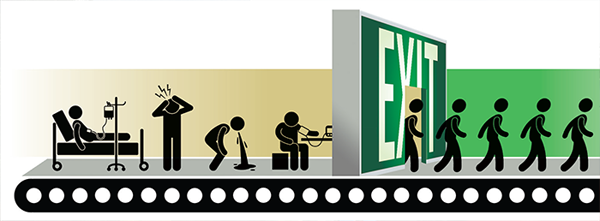
Improvements in the intake flow lead to improvements in overall patient flow through the ED, most notably for patients who are treated and released. The median length of stay for treat-and-release patients has decreased to 147 minutes and less than that for EDs that serve primarily pediatric populations. The EDs over 40,000 volume treat and release patients in a median of 169 minutes; that decreases to 130 minutes for patients seen in EDs under 40,000 volume.
Explore This Issue
ACEP Now: Vol 34 – No 07 – July 2015Improvements in the intake flow lead to improvements in overall patient flow through the ED, most notably for patients who are treated and released.
It is critical to reduce the number of persons who enter the ED but leave prematurely at any point. The EDBA and other oversight bodies, realizing that definitions can be very important to consistency in reporting, have developed an inclusive term: “left before treatment complete.” This single statistic provides the most complete accounting for all patients who leave the ED before they are supposed to, and it includes those patients who leave before or after the medical screening exam, those who leave against medical advice, and those who elope.
The flow improvements found using early contact with a provider have resulted in many EDs with volumes over 30,000 placing a provider in the intake process. There are at least 91 EDs that have physicians in the greeting process and at least 88 that use APPs in that role. That means these new forms of “team greeting” systems are present in more than 28 percent of EDs over 30,000 volume.
There is considerable discussion about the role of information systems, which have received billions in funding from the federal government, related to productivity and effectiveness of physicians who serve in hospitals. Many ED leaders have noted a loss of productivity and decrease in patient flow when information systems do not support the clinical role of physicians and APPs.
It is critical that all ED leaders, emergency physicians, and APPs provide consistent feedback to the major software vendors (Cerner, Epic, McKesson, Meditech, and so forth) to improve the performance of those systems. The software and other technologies must serve as tools that improve the services and work capabilities of our providers. They must use the industry definitions related to ED performance measures and produce dashboards that provide live feedback to improve intake, flow, and patient experience of care. Emergency physicians must step up to the important role in driving the information system developers to help move the industry ahead.
Pages: 1 2 3 | Single Page






One Response to “Emergency Department Flow, Patient Walkaway Key Performance Measures”
July 28, 2015
William WatkinsDid those EDs that place a provider in the intake system comment on how that provider is compensated for their work? If they are all salaried positions, it would not make a difference. Were there any groups placing a provider in the intake process that operated on a fee-for-service model? Did the improvement in efficiency cover the expense of placing a provider in a fee-for-service model in the intake process?